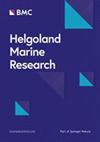Genetic and morpho-physiological differentiation in a limpet population across an intertidal gradient
4区 地球科学
Q2 Agricultural and Biological Sciences
引用次数: 5
Abstract
Marine organism adaptive capacity to different environmental conditions is a research priority to understand what conditions are important in structuring the spatial distribution of natural populations. In this context, this study evaluates whether potential differences in Siphonaria lessonii morphology (size and shell shape) and physiology (water loss regulation) at different shore heights are linked to genetically distinguishable individuals. To achieve this goal, we compared size-frequency distribution, morphometric, and genetic data (ISSR-PCR technique) of S. lessonii from the upper, middle and lower shore. We complemented these field samplings with laboratory experiments on water loss and mortality. Genetic analysis showed different genetic composition for individuals from the upper and lower shore. This pattern was accompanied by morpho-physiological variations: the upper shore had fewer small limpets, lower shell shape dispersion (with a morphotype characterized by a higher shell), and less water loss and mortality related to air exposure than the lower shore. The results reported herein support the idea that the extreme and unpredictable conditions of the upper shore may impose strong selection pressure on its inhabitants, leading to considerable morpho-physiological differentiation consistent with different genetic composition. This probably plays an important role in structuring the spatial distribution of natural S. lessonii populations with a possible effect on size-structure distribution.潮间带梯度中帽贝种群的遗传和形态生理分化
海洋生物对不同环境条件的适应能力是了解哪些条件对自然种群的空间分布结构重要的研究重点。在此背景下,本研究评估了不同海岸高度下小虹吸的形态(大小和壳形状)和生理(失水调节)的潜在差异是否与遗传可区分的个体有关。为了实现这一目标,我们比较了来自上、中、下游的s.l onii的大小-频率分布、形态计量学和遗传数据(ISSR-PCR技术)。我们对这些实地取样进行了补充,并对失水和死亡率进行了实验室试验。遗传分析表明,上游和下游个体的遗传组成不同。这种模式伴随着形态生理变化:与下游相比,上游有更少的小帽贝,更低的贝壳形状分散(以更高的贝壳为特征的形态),更少的水分损失和与空气暴露相关的死亡率。本文报道的结果支持了这样一种观点,即极端和不可预测的上游条件可能对其居民施加了强大的选择压力,导致了与不同遗传组成相一致的相当大的形态生理分化。这可能在构造自然种群的空间分布中起重要作用,并可能对大小结构分布产生影响。
本文章由计算机程序翻译,如有差异,请以英文原文为准。
求助全文
约1分钟内获得全文
求助全文
来源期刊

Helgoland Marine Research
地学-海洋学
自引率
0.00%
发文量
0
审稿时长
6-12 weeks
期刊介绍:
Helgoland Marine Research is an open access, peer reviewed journal, publishing original research as well as reviews on all aspects of marine and brackish water ecosystems, with a focus on how organisms survive in, and interact with, their environment.
The aim of Helgoland Marine Research is to publish work with a regional focus, but with clear global implications, or vice versa; research with global emphasis and regional ramifications. We are particularly interested in contributions that further our general understanding of how marine ecosystems work, and that concentrate on species’ interactions.
 求助内容:
求助内容: 应助结果提醒方式:
应助结果提醒方式:


